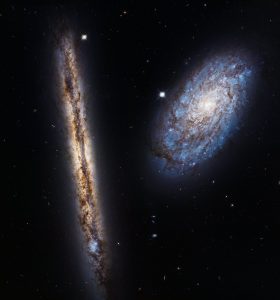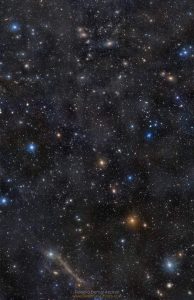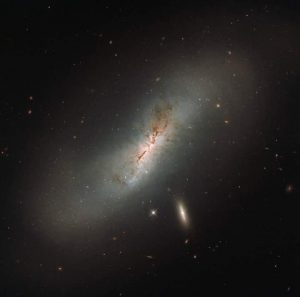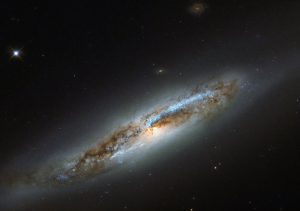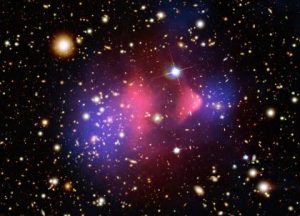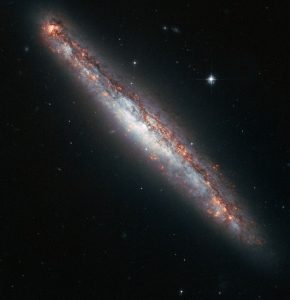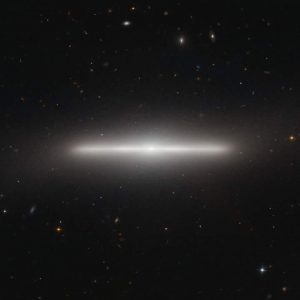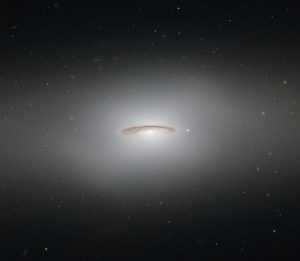Ammasso della Vergine
Galassia a spirale M100
 Posta nella Chioma di Berenice, M100 è una galassia a spirale facente parte dell’Ammasso di galassie della Vergine. Continua a leggere
Posta nella Chioma di Berenice, M100 è una galassia a spirale facente parte dell’Ammasso di galassie della Vergine. Continua a leggere
Una Coppia Straordinaria
Questo straordinaria accoppiata cosmica delle due galassie a spirale NGC 4302 e NGC 4298, dall’aspetto molto differente tra loro, è stata immortalata dal telescopio Hubble. L’immagine riprende in modo splendido il vivido bagliore stellare e le scure, screziate, formazioni di polvere. Continua a leggere
Dalla Catena di Markarian a Messier 64
Questo splendente, ampio mosaico di immagini collega dall’alto in basso la Catena di galassie di Markarian, attraverso il cuore dell’Ammasso della Vergine, fino alla galassia a spirale Messier 64. Continua a leggere
NGC 4424 e la sua compagna
In questa nuova, straordinaria immagine di Hubble sono chiaramente visibili due galassie, la più grande delle quali si chiama NGC 4424. Questa galassia è inserita nel New General Catalogue of Nebulae and Clusters of Stars (NGC), compilato nel 1888. Continua a leggere
Metamorfosi nella Vergine
Questa volta l’obiettivo del telescopio Hubble è una galassia molto particolare, NGC 4388, soggetta suo malgrado ad una trasformazione radicale che ne ha alterato l’intera struttura, quasi si trattasse di una vera e propria metamorfosi. Continua a leggere
Ammassi di Galassie in Collisione
Molte galassie fanno parte di ammassi galattici, strutture cosmiche fra le più grandi nell’Universo, tenute insieme dalla gravità. La nostra Via Lattea, ad esempio, fa parte del Gruppo Locale, un insieme di una cinquantina di galassie fra le quali la più grande è la galassia di Andromeda. Il vasto ammasso di galassie più vicino a noi, ad una distanza di circa 50 milioni di anni luce, è l’Ammasso della Vergine, che ospita intorno ai 2000 oggetti. Continua a leggere
Fontana Galattica
Questa spettacolare immagine del telescopio Hubble mostra il profilo di taglio dell’esile galassia a spirale NGC 5775. Anche se la spirale è inclinata in questo modo rispetto a noi, una simile prospettiva può essere vantaggiosa per gli astronomi, perché le regioni sopra e sotto il disco galattico possono essere osservate più chiaramente. Continua a leggere
Una Galassia Straordinariamente Sottile
Questa sorprendente galassia, chiamata NGC 4452, appare esattamente di taglio se osservata dalla Terra, permettendoci di ammirare una straordinaria immagine di miliardi di stelle viste da un’insolita angolazione. Continua a leggere
Serenità apparente in NGC 4526
Questa piccola elegante galassia ripresa dal telescopio Hubble è conosciuta come NGC 4526. Le sue fasce oscure di polvere e il bagliore diffuso le conferiscono l’aspetto affascinante di un’alone sospeso nel vuoto dello spazio. Continua a leggere
